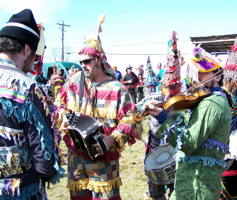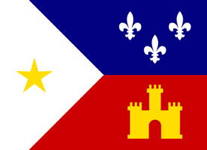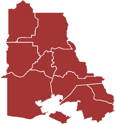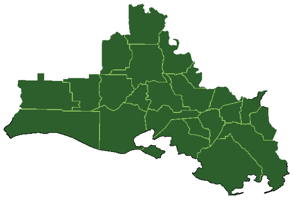
|
The Society of Folk Dance Historians (SFDH) Cajuns
[
Home |
About |
Encyclopedia | CLICK AN IMAGE TO ENLARGE |

|
 The Cajuns, also known as Acadians, are an ethnic group living mainly in the United States state of Louisiana. In Louisiana, Acadian and Cajun are often used as broad cultural terms without reference to actual descent from the deported Acadians. Historically, Louisianians of Acadian descent were also considered to be Louisiana Creoles, although Cajun and Creole are often portrayed as separate identities today. The Cajuns make up a significant portion of south Louisiana's population and have had an enormous impact on the state's culture.
The Cajuns, also known as Acadians, are an ethnic group living mainly in the United States state of Louisiana. In Louisiana, Acadian and Cajun are often used as broad cultural terms without reference to actual descent from the deported Acadians. Historically, Louisianians of Acadian descent were also considered to be Louisiana Creoles, although Cajun and Creole are often portrayed as separate identities today. The Cajuns make up a significant portion of south Louisiana's population and have had an enormous impact on the state's culture.
 The Cajuns trace their roots to the influx of Acadian settlers after the Great Expulsion from their homeland from the Maritimes of Eastern Canada. Since their establishment in Louisiana, the Cajuns have become famous for their unique French dialect, Louisiana French (also called "Cajun French," although the dialect predates the Acadians' arrival in Louisiana), and have developed a vibrant culture including folkways, music, and cuisine.
The Cajuns trace their roots to the influx of Acadian settlers after the Great Expulsion from their homeland from the Maritimes of Eastern Canada. Since their establishment in Louisiana, the Cajuns have become famous for their unique French dialect, Louisiana French (also called "Cajun French," although the dialect predates the Acadians' arrival in Louisiana), and have developed a vibrant culture including folkways, music, and cuisine.
Geography had a strong correlation to Cajun lifestyles. Most Cajuns resided in Acadiana, where their descendants are still predominant. Cajun populations today are found also in the area southwest of New Orleans and scattered in areas adjacent to the French Louisiana region
 Cajun music is evolved from its roots in the music of the French-speaking Catholics of Canada. In earlier years, the fiddle was the predominant instrument, but gradually the accordion has come to share the limelight. In the late 1980s, Roy Hilburn introduced Louisiana Cajun dancers to an Austrian folk dance called Zillertaller Ländler, whose motifs inspired an entire dance movement.
Cajun music is evolved from its roots in the music of the French-speaking Catholics of Canada. In earlier years, the fiddle was the predominant instrument, but gradually the accordion has come to share the limelight. In the late 1980s, Roy Hilburn introduced Louisiana Cajun dancers to an Austrian folk dance called Zillertaller Ländler, whose motifs inspired an entire dance movement.
Mardi Gras (French for "Fat Tuesday," also known as Shrove Tuesday) is the day before Ash Wednesday, which marks the beginning of Lent, a 40-day period of fasting and reflection in preparation for Easter Sunday. Mardi Gras was historically a time to use up the foods that were not to be used during Lent, including fat, eggs, and meat. Mardi Gras celebrations in rural Acadiana are distinct from the more widely known celebrations in New Orleans and other metropolitan areas. A distinct feature of the Cajun celebration centers on the Courir du Mardi Gras (translated: fat Tuesday run).
The majority of Cajun festivals include a fais do-do ("go to sleep" in French, originating from encouraging children to fall asleep in the rafters of the dance hall as the parents danced late into the night) or street dance, usually to a live local band. Crowds at these festivals can range from a few hundred to more than 100,000.
Language: Cajun English, a French-influenced dialect of English
Religion: Catholic
DOCUMENTS
- Cajun Music – The Soul of Adadiana, an article.
- Cajun Music and Dance Weekend, a camp.
- Courir du Mardi Gras, an article.
- Louisiana French Dancing, an article.
This page © 2018 by Ron Houston.
Please do not copy any part of this page without including this copyright notice.
Please do not copy small portions out of context.
Please do not copy large portions without permission from Ron Houston.